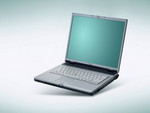Fujitsu-Siemens Lifebook E8110
Specifications

Price comparison
Average of 3 scores (from 5 reviews)
Reviews for the Fujitsu-Siemens Lifebook E8110
Source: PC Authority
 Archive.org version
Archive.org versionIt may look like a bit of a dinosaur design, but the nimble performance and excellent battery life make up for the looks. It has to be said that the Fujitsu looks a little dated in design. It's blocky and square and its 1280 x 800 resolution makes it seem far more old-fashioned than it actually is. It's a nice overall package, but given the price of the Dell Inspiron 1470 for not much less performance, it's hard to recommend the Fujitsu for anything except its lovely screen.
Single Review, online available, Medium, Date: 02/19/2010
Rating: performance: 80% mobility: 90%
Foreign Reviews
Source: Connect
 DE→EN Archive.org version
DE→EN Archive.org versionSingle Review, , Length Unknown, Date: 02/20/2007
Rating: Total score: 100% performance: 70% features: 100% display: 90% mobility: 70% ergonomy: 80%
Source: Notebook / Organizer / Handy
 DE→EN Archive.org version
DE→EN Archive.org versionSingle Review, , Length Unknown, Date: 05/01/2006
Rating: Total score: 95% price: 85%
Source: ZDNet
 DE→EN Archive.org version
DE→EN Archive.org versionSingle Review, , Length Unknown, Date: 03/03/2006
Rating: Total score: 78% performance: 90% features: 80%
Source: Connect
 DE→EN Archive.org version
DE→EN Archive.org versionSingle Review, , Length Unknown, Date: 03/01/2006
Comment
Intel Graphics Media Accelerator (GMA) 950: Intel Graphics Media Accelerator 950 is an integrated (onboard) graphic chip on Mobile Intel 945GM chipset. It is a faster clocked version of the GMA 900 and supports no hardware T&L (Transform & Lightning) accelleration (which is required for some games).
These graphics cards are not suited for Windows 3D games. Office and Internet surfing however is possible.
» Further information can be found in our Comparison of Mobile Graphics Cards and the corresponding Benchmark List.
Intel Core Duo: Double Core processor with a very good relation of performance to current consumption. The 2 MB L2 Cache are used together by the double. The maximum capacity of 31 watts is only 4 watts more than with the Pentium M (predecessor). Both cores are lowered automatically and independently of each other by speed steps down to 1 GHz. In addition it now supports also SSE3 instructions. At least it is just as fast as a equivalent Pentium M. With applications, which were designed for multi-processors, the performance can be nearly twice as fast as with the Pentium M (e.g. CineBench around 86% fast)
T2400: » Further information can be found in our Comparison of Mobile Processsors.



